It’s easy to get confused about priorities. We do it all the time. But getting confused about priorities in a survival situation could have lasting consequences. It’s not all that easy to recover from death. So, if you’re ever caught in a survival situation, make sure that you keep track of your priorities.
That basically boils down to two things. The first is what you carry in your pack. Whether we’re talking about a bug out bag or just going backpacking, you’ve got to make sure you allocate the space and weight needed for those priorities, even if it means you can’t take something else you’d like to. The second is what you do first, when you stop traveling for the night. Things can happen and you need to make sure that you take care of your priorities, before taking care of less important things.
We all know the little bit of poetry we call the “Rule of 3s” – “It takes 30 minutes to die of hypothermia, 3 days to die of lack of water and 30 days to die of lack of food.” With that being the case, our first priority in packing and setting up camp, is ensuring that we can keep ourselves warm enough.
But carrying around a shelter is difficult. Even the lightest of backpacking tents are a major addition to the average bug out bag. So many of us leave them home. That’s okay, as long as we’re ready to make our own shelter when we’re out there in the wild. Shelter doesn’t have to be commercially bought, it just has to keep you warm and dry.
Nature helps us here, by providing a plethora of useful materials which can be incorporated into a shelter. Tree branches provide structural elements, insulation and watershed. We can get more insulation from fallen leaves, we can even get cordage by twisting or braiding long grass into it.
But we always need a starting point for our shelter. That usually means something that nature has provided, which at least gives us some protection from the elements. More than anything, we’re looking for something to give us protection from wind and rain. So, we need to look for things like:
- Caves – Caves are the ultimate wilderness shelter, although a bit hard to find. You can often walk right by a cave entrance, without even seeing it. But if you do find one, make sure it is unoccupied, before setting up camp. Caves in the wild are seldom ignored by animals, who like them for their dens.
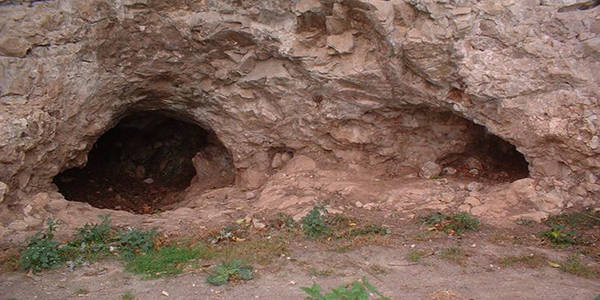
- Rock outcroppings – While not as good as a cave, a rock outcropping can form a great basis for a shelter, giving you a good windbreak and at times even protection from the rain. It also provide good cover from gunfire, if you are in a situation where you need to defend yourself.
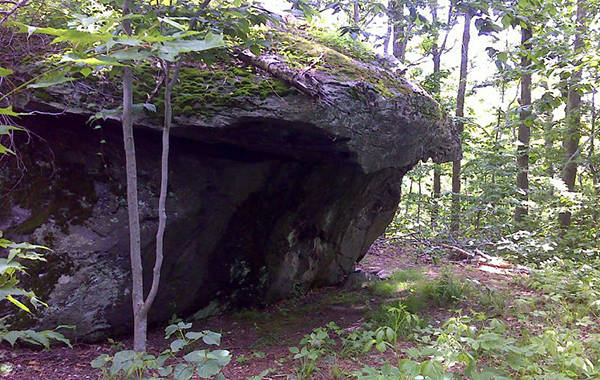
- Undercut banks – Water flowing down a canyon or gully can carve out a depression, somewhat like a wide, shallow cave. The giant caves of Mesa Verde were formed this way. Large or small, they provide most of a shelter, ready-made. All you really need to do is close off the entranceway or put up a head reflector there.
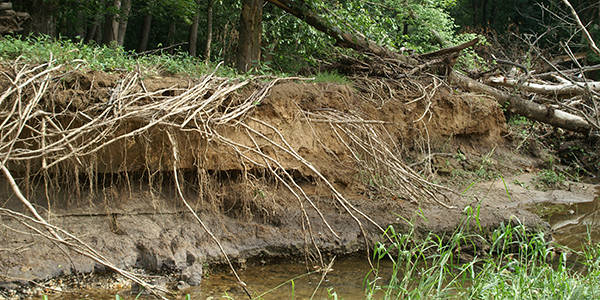
- Uprooted trees – Sometimes, a tree will be uprooted by a storm, especially on steep mountainsides, when previous rains have undermined the tree’s foundation. When this happens, it offers two great areas that can be made into shelters: under the trunk, if you clear out some branches and the root mass. That solid wall can become a great starting place, especially if it is upwind of you.
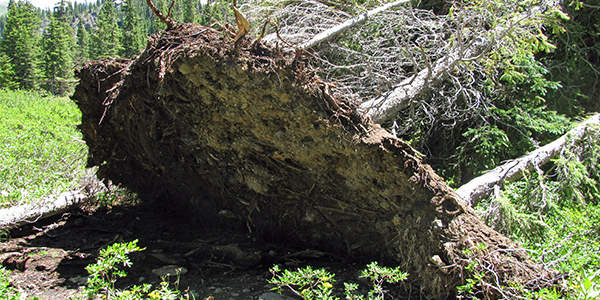
- Thickets – Close growing trees offer great protection from the wind, as well as some protection from the rain. If you find a tight thicket, you can cut some of the saplings out of the middle, allowing the rest to form the walls and roof of your shelter.
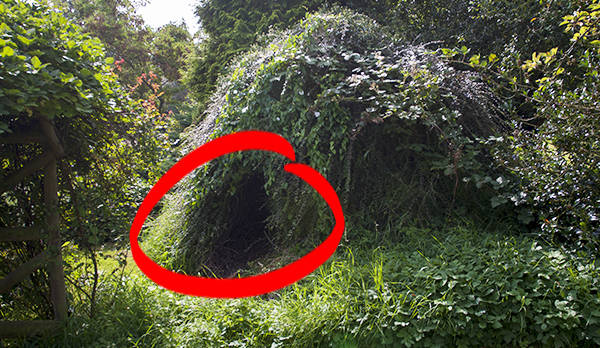
- Inside a Tree Trunk – Hollow trees are not that rare. Almost every time I go out in the woods I spot one or two.
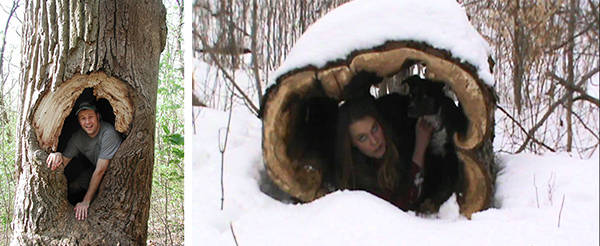
- Man-made artifacts – It’s amazing some of the places you’ll find the remnants of an old building, a standing chimney with no building nearby or an abandoned car. All of these are useful as a starting point for making a shelter, giving you at least part of a structure to work with.
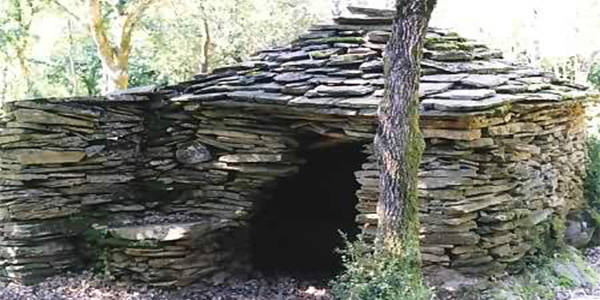
Once you’ve got your starting place, you need to finish it out, giving yourself protection from the wind and rain. I always carry a tarp with me, as well as one of the tough space blankets (which can serve as another tarp). With some paracord and duct tape, you can make a lot of different styles of shelter out of a simple tarp.
Green branches laid over other branches do well at shedding water. You need to start from the bottom up and lay the branches overlapping each other. Put the branches upside-down (with the tips of the branches pointing down) to help with watershed. Tie them in place, or hook them over a pole, using a “Y” in the branch.
These branches will also help act as insulation. Additional insulation can be added to your shelter by piling leaves or pine needles off the forest floor around it. Don’t forget to pile them inside as well, to insulate you from the ground. Cold ground will sap your body’s heat faster than cold air can.
The entry to your shelter should always be downwind during cold times and upwind during warm ones. By putting it downwind, you help keep the wind out of the shelter, so that you don’t have to keep heating new air over and over again. But in warm weather, putting the door upwind will help keep mosquitoes out of your shelter.
Finally, place your fire carefully, so that it can provide you with some heat, while not putting your shelter at risk of catching fire. Take the wind into account, when thinking of this. Wind can blow the flames towards your shelter, just as easy as away from it. A backdrop of stone or logs will help act as a heat deflector, radiating heat from the fire into your shelter.
When you move on, you can leave your shelter for the next traveler who comes along. However, make sure that no animals could get caught inside your shelter. Even something simple can turn a shelter into a trap for animals, causing them to die needlessly.
You may also like:
 A Small, Super Survival Shelter
A Small, Super Survival Shelter
H2O Dynamo – The Awesome Device That Turns Air Into Water (Video)
5 Bad-ass Perimeter Defense Lessons From A Vietnam Vet

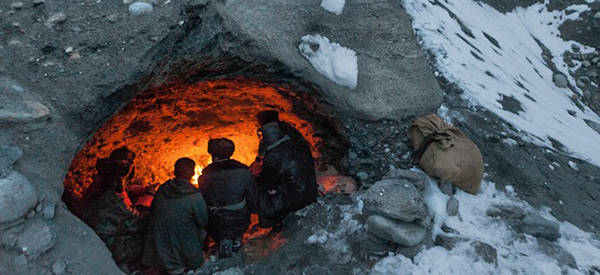














About your “Rules of 3’s”. A more complete list is as follows.
3 minutes without oxygen.
3 minutes of major blood flow.
30 minutes for hypothermia.
3 days without water.
3 weeks without food.
3 months without human contact.
Final note- If you get to a half way point on any of these. You will most likely die without outside help. Your thinking will be off kilter & you’ll make mistakes.
Thank you for your consideration.
Obviously you have never tried to sleep in a tree trunk in the areas I have wandered. Every hollow tree trunk I have come across is a haven for bugs, most of which seem to like sucking blood. Before using any natural shelter, whether it is a tree trunk or cave it is a good idea to heavily smoke the area with a smudge fire and be sure that the smoke gets into all crevices. Waking up in the night with a centipede (very painful) bite is no fun. In a cave, if it is large, smoking is not practical but smoking the area you intend to sleep in is also a good idea. In a small cave I have driven out animals that were undetected prior to the smoke.
Taking shelter at an undercut bank is just bad advise. the bank gets undercut from water running past is right so taking shelter there can get you drowned. it doesn’t have to be raining where you are to get hit with a flash flood. also the bank can collapse at any time.
I think the best advice is to find a super large pint pine tree with with large branches on the outside and huddle right next to the trunk….. I have done this countless times in the back country and it works every time except for the most extreme downpours downpours.
That’s not even 10 miunets well spent!
I think the best advice is finding a very large tree like a pine tree with long branches and huddling right near the trunk. I have done this numerous times in the back country and it works wonderful except for the most extreme conditions you can get a little more wet but overall overall works great
rule of 3s
3 seconds without thinking